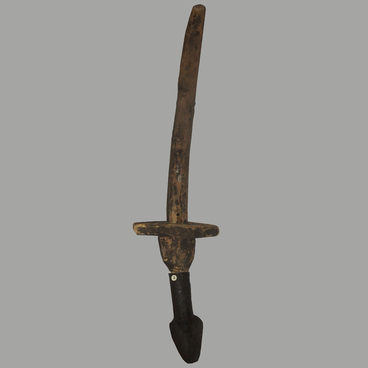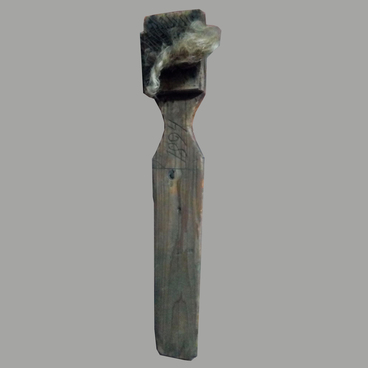The Quiver Hook was discovered during investigations on the archeological site Yesaulskiye Kurgany (Yesaulsky burial mounds), in grave mound No.2. This group of burials dating back to the 1st millennium is located in the Kemerovo Region, near the village of Yesaulki.
The Yesaulsky burial mounds contained various artefacts of the Upper Ob’ culture of the 8th - 9th centuries. Scientists discovered that Samoyedic and Ural-Siberian tribes that inhabited the Upper Ob’ Region used the burial mounds to bury dummies with remains of the dead and to put various accessories there. Archeologists succeeded in finding fragments of clothes decorated with bronze plates, and also elements of arms, in particular, fragments of bows and arrows that, judging by the artefacts found, Upper Ob’ tribes had used quite often.
Scientists concluded that quivers were important accessories in the life of Upper Ob’ tribes, as they were left in the burials alongside with weapons. Whole quivers did not survive to this day as they were made of leather, wood, birchbark and other organic materials that decompose in the soil with time. Only metal fasteners survived in most burial mounds that were used to hook quivers to waist or back belts. Those include the exhibited hook made of round iron rods.
When investigating the burials, archeologists also found fragments of various close combat weapons. In that way they identified that the Upper Ob’ tribes used broadswords with long straight blades. Scientists believe that in the taiga zone of West Siberia broadswords remained widely used much longer than in the steppe and forest-steppe zones: up to 17th century.
Another popular weapons with the Upper Ob’ tribes were spears with metal, most often iron heads. The spearheads had hexagonal form and lens-shaped or rhomb-shaped section.
In addition, at the Upper Ob’ burial sites, archeologists found combat knives and elements of protective armor made of iron, as well as metal parts of horse harness: bridle-bit, stirrups and decorations.
The Yesaulsky burial mounds contained various artefacts of the Upper Ob’ culture of the 8th - 9th centuries. Scientists discovered that Samoyedic and Ural-Siberian tribes that inhabited the Upper Ob’ Region used the burial mounds to bury dummies with remains of the dead and to put various accessories there. Archeologists succeeded in finding fragments of clothes decorated with bronze plates, and also elements of arms, in particular, fragments of bows and arrows that, judging by the artefacts found, Upper Ob’ tribes had used quite often.
Scientists concluded that quivers were important accessories in the life of Upper Ob’ tribes, as they were left in the burials alongside with weapons. Whole quivers did not survive to this day as they were made of leather, wood, birchbark and other organic materials that decompose in the soil with time. Only metal fasteners survived in most burial mounds that were used to hook quivers to waist or back belts. Those include the exhibited hook made of round iron rods.
When investigating the burials, archeologists also found fragments of various close combat weapons. In that way they identified that the Upper Ob’ tribes used broadswords with long straight blades. Scientists believe that in the taiga zone of West Siberia broadswords remained widely used much longer than in the steppe and forest-steppe zones: up to 17th century.
Another popular weapons with the Upper Ob’ tribes were spears with metal, most often iron heads. The spearheads had hexagonal form and lens-shaped or rhomb-shaped section.
In addition, at the Upper Ob’ burial sites, archeologists found combat knives and elements of protective armor made of iron, as well as metal parts of horse harness: bridle-bit, stirrups and decorations.


